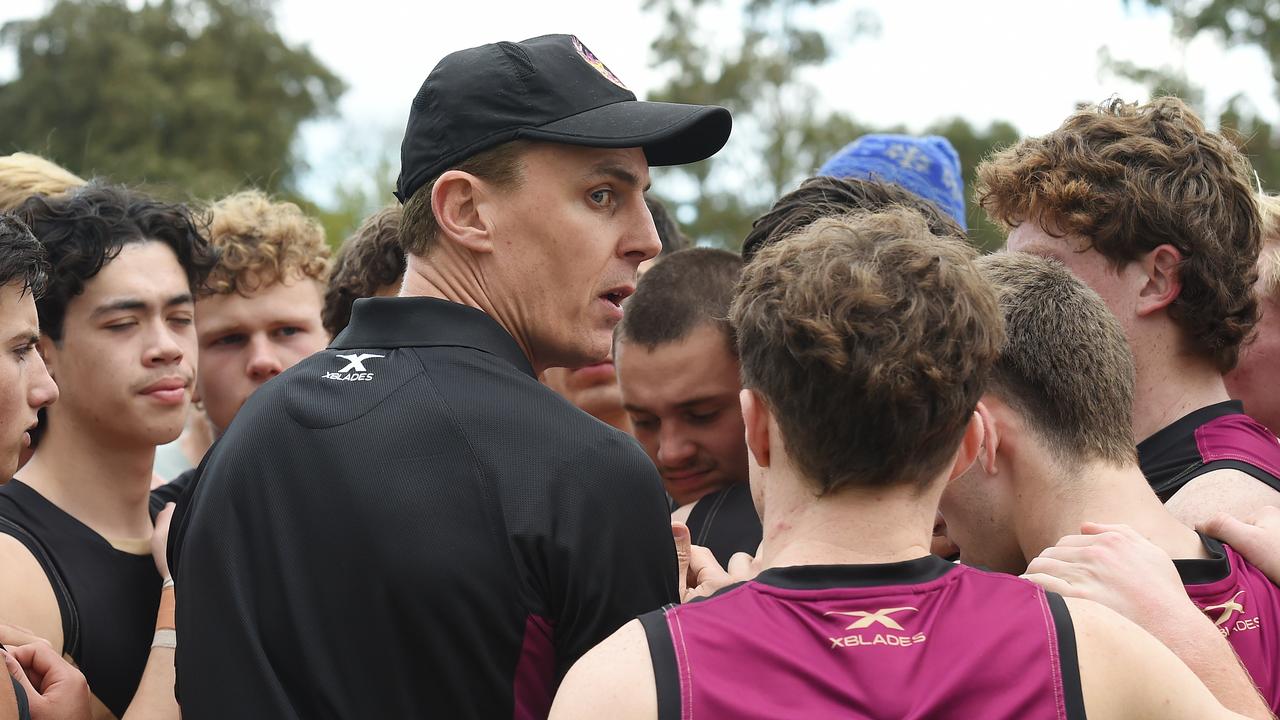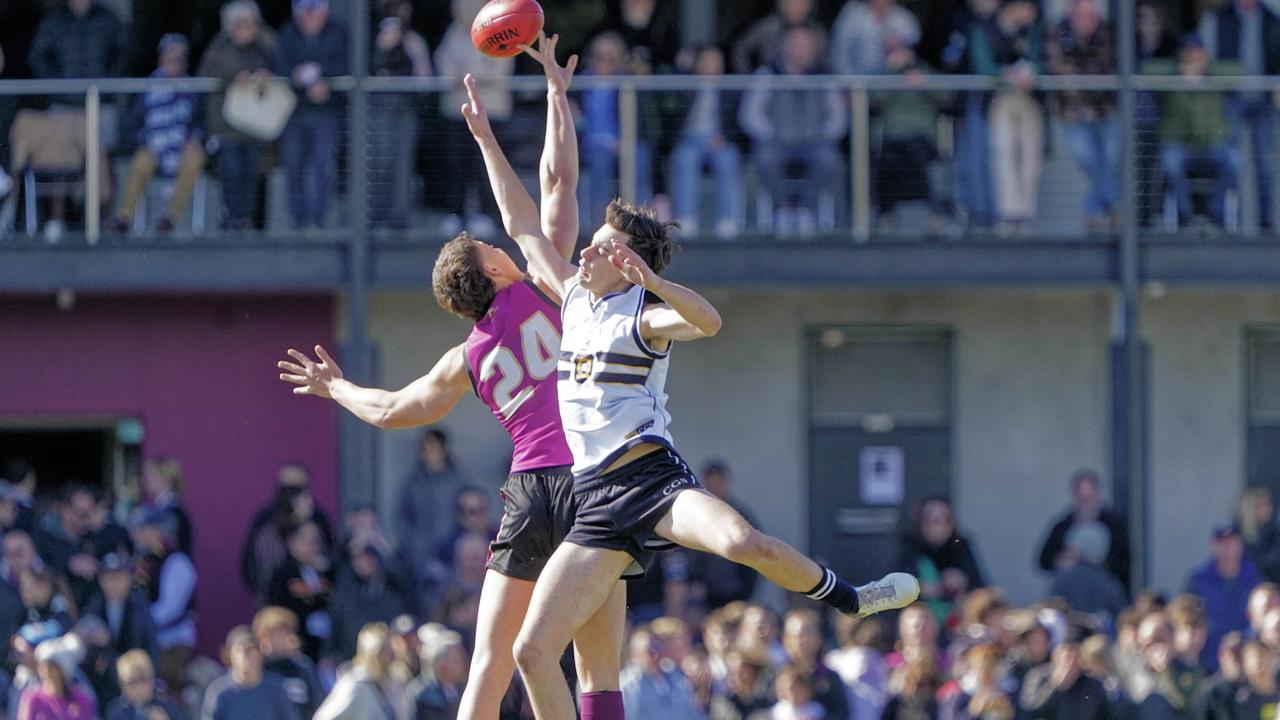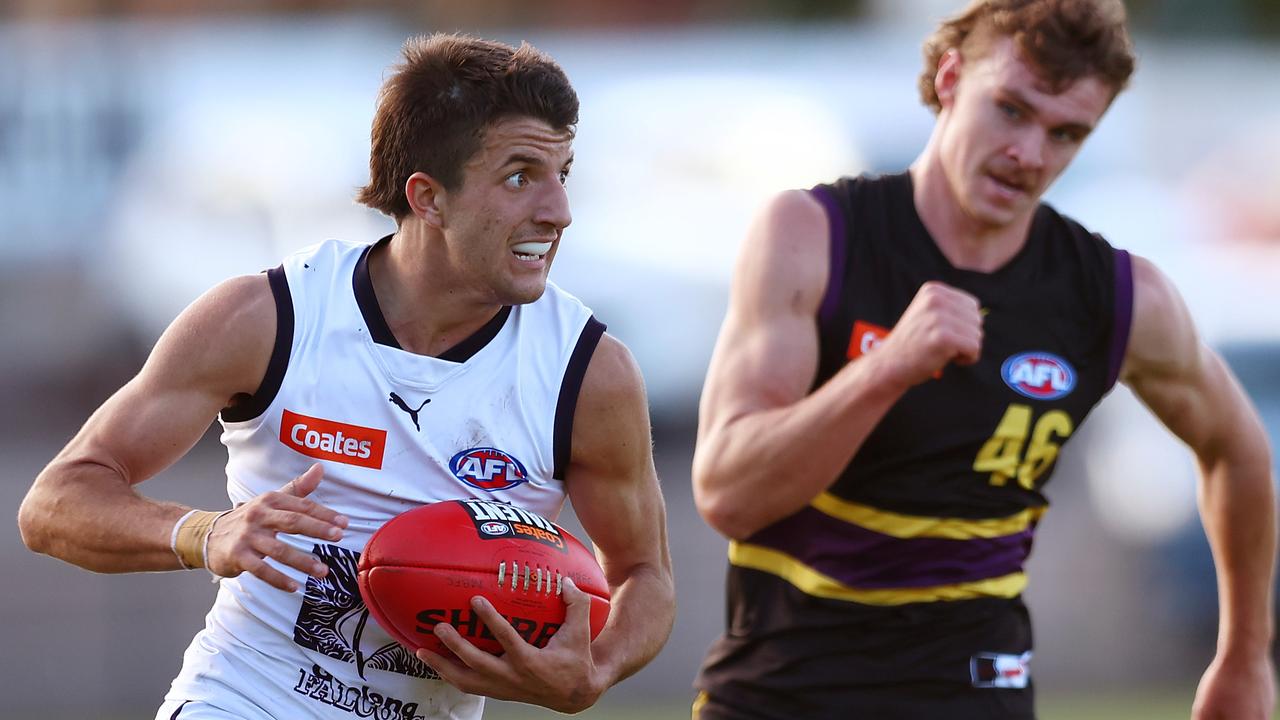Inside the perks and pitfalls of private school football and the concerns from Coates Talent League regions
Ahead of Monday’s AFL Draft, we investigate how and why rich private schools pay big bucks for young talent and why some believe scholarships come with warning signs.

Sport
Don't miss out on the headlines from Sport. Followed categories will be added to My News.
It’s a familiar story in the AFL draft landscape.
A talented prospect who attended an elite private school is drafted into the AFL ranks.
This publication revealed this week that 78 per cent of this year’s top 87 prospects attended private schools.
In Victoria, the most highly regarded private school football competition is the Associated Public Schools of Victoria (APS), which features prestigious schools such as Caulfield Grammar, Haileybury, Geelong Grammar and Xavier College, just to name a few.
The intensity of the environment has ramped up in the past decade, with competition fierce between schools and prospective draftees eager to attend these schools.
So why do kids choose to play in this competition?
They get access to state of the art facilities, coaches and support staff.
Country talents can get the opportunity to head to the big smoke and board, helping enhance their maturity and taking them out of their comfort zone.
Clearly, football isn’t everything, and these students also receive a private school education by attending these schools. And some have their fees slashed with the help of scholarships.
It’s an opportunity that is difficult to pass up, especially with the chance to learn off players who have had success at the elite level.
Take Haileybury for instance. Essendon legend Matthew Lloyd coaches its football team, as he has for close to a decade. Collingwood champion Scott Pendlebury is the team’s midfield coach and 302-game former Demon Nathan Jones leads their Year 10 side.

That’s hugely appealing for a draft hopeful looking to get the extra edge in the pursuit of achieving their AFL dream.
Xavier College brought in alumnus Jobe Watson to coach their football team this year, but football director Dale Amos, who previously fulfilled an assistant coaching role at Carlton and coached Geelong’s VFL side, says it was about more than just attracting a former AFL player.
“Jobe brings a wealth of life experience and he is an old boy who has been here before. Gives a great passion for the school, he had a great experience when he was here,” Amos said.
“A lot of value with Jobe hasn’t just been on game day but life lessons and the ability to understand expectations and values and standards… a really appealing factor with Jobe that drew us to him as part of the program.”
SCHOLARSHIPS
All schools do scholarships differently.
There is a perception from rival schools and those in the talent pathway that APS powerhouses Caulfield Grammar and Haileybury, who were the top two teams in the competition this year, hand out more than others, but this is merely speculation.
Player agents are seeing more of their junior prospects being offered scholarships and more schools getting in on the act to remain competitive.

It has become common for private schools to approach young talents and their parents with scholarships after the under-16 national development championships, when there is a greater awareness of who the most highly-touted players are.
One former private school staffer claimed that some schools had relationships with under-12 and under-15 Victorian state football sides, helping them attract the best talent from a young age.
But this is not to say that every talented footballer at a private school is approached. Many inquire to the schools themselves, while others might already be attending, or were enrolled in the school for reasons other than football.
Many private schools offer scholarships that cover all or half of school fees for sport or general excellence. Some schools, like Melbourne Grammar, have a strict entrance policy for scholarships which requires passing an entrance exam.
The entry points for scholarships vary as well. For Carey Grammar it is Year 7 and 10, and principal Peter Robson said their scholarships generally cover half of their school fees.
As an example, Carey Grammar’s school fees are $34,500 for Year 11 and 12. For a boarding school like Geelong Grammar, their fees are much higher at $84,240 per year.
Robson rejected the assertion that schools hand out lots of scholarships to fuel their football sides.
“I can only talk to Carey but we are really open about it, it would be 50 per cent omission of fees, that’s probably standard. We know some schools will give 100 per cent, some give 25, but we are pretty consistent with it,” Robson said.
“The perception that private schools have an extensive scholarship program, I just don’t think that’s the reality.
“There is good coaching, you’d be surprised some of those students that come through the school, they are not always on scholarship.”
Geelong College were one of the best teams in the APS 15 years ago, but since making the call not to offer sport scholarships when other schools made the shift, their results in the APS competition have been significantly impacted.

They have been cellar-dwellers in the competition since but saw improvement this year, knocking off hometown rival Geelong Grammar, a school that offers sports scholarships, for the first time in 10 years.
This is a common theme in APS and AGSV football, where some coaches feel they aren’t on a level playing field. But there is a general feeling that schools focus on their own programs and work within their own limits.
Geelong College director of football Nathan Brown, who played 183 games for St Kilda and Collingwood, said that having scholarships is “irrelevant”.
Joining Geelong College at the start of the season, he is planning to build the school’s program from the ground up.
“When I first got an introduction to the program, if I had a dollar for every time a parent or someone within the community said that to me, ‘You’re going to find it hard with no scholarships’,” Brown said.
“It’s really irrelevant, whether we do one day or not it doesn’t matter in terms of what I’m trying to do now and build now.
“If you build a strong, positive culture and a culture of growth and development, who’s to say you need scholarships?”
EYES ON THE APS
Another incentive of APS football in particular is the attention it receives from AFL recruiters.
The APS competition has become another closely watched competition for talent scouts, with recruiters flocking to private school games in Victoria to catch a glimpse of the top-end talent on show.
While it is rare that a player gets drafted solely out of APS football, it can help a player get seen.
Geelong duo Max Holmes and Ollie Dempsey are among the players who have burst on to the draft scene largely due to their form at APS level.
Last year speedster Bailey Macdonald bolted into the draft frame off the back of his form for Wesley College, resulting in him being called up to the Oakleigh Chargers mid-year and being called out by Hawthorn at pick 51.
However, the school of thought that draft prospects are more likely to be drafted if they come through an APS program has been rubbished by recruiters.
If anything, most recruiters say they put an asterisk on APS football, with Coates Talent League performances receiving higher weighting.
Those in the APS industry believe that the standard has improved in the past five years, but there is still a glaring gap between the best and worst players compared to the elite talent pathway.
Several recruiters pointed to potential top-five selection Nick Watson’s form for Caulfield Grammar.

They won’t glean much on Watson kicking a bag of goals against a lowly ranked APS side, especially when he was often playing as a full forward – a role the 169cm talent won’t be playing at AFL level.
And the gulf is even more significant in other school competitions.
In the Associated Catholic Colleges, Sandringham Dragons prospect Luke Lloyd kicked a whopping 19 goals in a school match for De La Salle in a 184-point win in May.
Lloyd, who remains in the draft mix, still wasn’t selected for Vic Metro in the national championships despite that performance.
Often private school football games are a marriage of convenience for talent watchers. Going to watch Caulfield Grammar, for instance, when there is no Coates Talent League matches on allows clubs to watch multiple players in the draft frame in one place.
ELEPHANT IN THE ROOM
Coates Talent League footballers who attend APS and Associated Grammar Schools of Victoria (AGSV) must play school football over their talent pathway matches.
Some clubs in the CTL believe this is the reason behind the decision to implement a community break, which sees them play four matches at the beginning of the season before players return to their community clubs or school football.
While CTL clubs have strong relationships with private schools, there is growing frustration about private school football jeopardising young prospects’ development.
They see prospects with their own eyes lose the progress that they had made earlier in the season once they return from private school football.
Geelong Falcons draft prospect Tom Anastasopoulos, who graduated from Geelong College this year, conceded that he found the adjustment difficult jumping from program to program.
Anastasopoulos burst onto the draft radar with 12 goals in his first four games in the CTL at the beginning of the year but struggled upon his return to the Falcons side and then for Vic Country at the national championships.
Just when he began to find his feet again for the Falcons, he was back to private school football again after school holidays were over.

“It is a lot harder because you play against some boys (in APS) who aren’t as good in defence wise,” Anastasopoulos said.
“Obviously with school as well with the speed of footy you’re kind of that player that people rely on so as a small forward it is hard to be relied on… I’m not really a midfielder.
“You come back in the Coates League and they are bigger, stronger, faster so you’re going to have to adapt to that and then Vic Country as well. You probably have to be even better, some of the best defenders around Australia.”
Private schools play in a different way, often with an emphasis on winning games rather than development, with CTL players tending to be the matchwinners for these sides.
CTL figures claim youngsters are forced to play in different roles that might not marry up to the positions they are taught in the CTL, which generally are AFL specific roles that can help a player get drafted.
There are also concerns that country regions could have their best talents stripped by metropolitan regions after receiving scholarships.
Koroit native Finn O’Sullivan, who looms as a top-five prospect in the 2024 AFL Draft, now plays at the Oakleigh Chargers after playing under-16 football at the GWV Rebels.
Twelve months ago draftees Toby McMullin, who hails from Port Fairy in GWV Rebels’ zone, and Jack O’Sullivan (Kyneton in Bendigo Piooners' zone), played for the Sandringham Dragons and Oakleigh Chargers after boarding at Melbourne Grammar and Xavier College respectively.
Those within the CTL industry who were critical of private school football would not speak publicly, with one saying that it would be “career suicide” to do so.
But Sandringham Dragons talent manager Mark Wheeler, whose side has an extended list compared to other CTL regions due to the large number of kids attending private schools, sees it differently.
While he acknowledges there are challenges and that there has been disputes in the past, he said they are working together to achieve the best results for the youngsters.
“70 per cent of my list is private school so I’ve definitely got a great relationship with the private schools. We work together probably the best we’ve ever had, coaches at both levels talk to each other and we probably look at the bigger picture together,” Wheeler said.
“Is it ideal for a young man playing four or five different levels of footy at different football clubs? It’s not ideal, but we make it work.
“We work really well together and have great communications with our schools and vice versa.
“That past issues that we had where it was us vs. them, it’s not us vs. them anymore.”
More Coverage
Originally published as Inside the perks and pitfalls of private school football and the concerns from Coates Talent League regions









